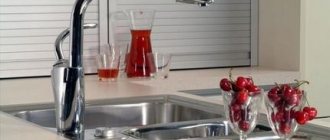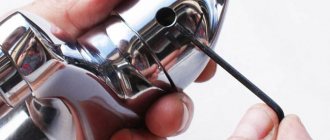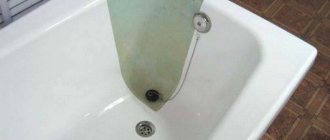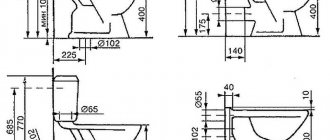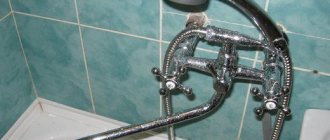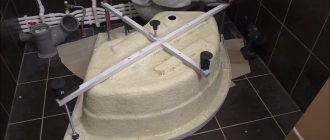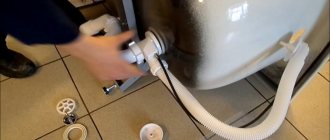Sooner or later, every owner of an apartment or house is faced with the need to replace a faucet. Some do this because of excessive wear and the impossibility of further use, others out of a desire to install a more advanced model. You don't need to be a professional plumber to cope with this task.
Just read the instructions below on how to change the faucet in the bathroom.
In what cases is replacement required?
Poor operation of a faucet is not always a reason to replace it.
If water drips or flows in a thin stream from the tap, you just need to replace the filling in it:
- in semi-rotary or lever: ceramic cartridge;
- in classic (valve): gasket.
Some joystick faucets have a metal ball with holes instead of a cartridge. In such devices, the cause of leakage is usually wear of the seat—the soft polymer insert adjacent to the ball—by abrasive particles.
If the tap of a classic valve mixer breaks, replace the tap axle (valve head).
Replacement of the entire device is inevitable in the following cases:
- body cracked. This happens with cheap faucets;
- The inside of the body is covered with rust. Happens with cheap faucets or fakes made from corrosion-unresistant material;
- the nut for connecting to the water supply has burst or its thread has been torn off. This is possible due to careless installation or leaning on the mixer.
Recommendations for selection
When purchasing a product, pay attention to its integrity, as well as all the necessary equipment, without leaving the checkout. These products come with a warranty during which replacement can be made.
When choosing a product, you need to pay attention to the length that is necessary for further comfortable use of the shower, as well as the diameter of the tube. For example, you can unscrew a broken hose and take it with you, and the seller will help you find an analogue for the old one.
An important criterion is the material that is used to protect the hose from external influences.
Of course, a metal hose will be the most durable and durable. However, plastic will help save your budget. Both options perform their main function - supplying water from the mixer to the watering can and ensuring comfortable water procedures.
Which mixer should I buy?
A new device to replace the old one is chosen based on the design of the locking mechanism, material and design.
Locking mechanism type
Classic valve mixers are considered obsolete - they are inconvenient to use, most users change them to:
. They are also equipped with two thumbwheels, but to open completely, you only need to turn the tap 180 degrees. To do this, the tap of the valve analogue has to be turned several times. The locking mechanism of the semi-rotary mixer is a cartridge of two ceramic plates with holes. The pressure depends on how well the holes line up. Semi-rotary faucets are more convenient than classic ones, but have the same main disadvantages: each time you have to adjust the water temperature, which increases its consumption, and manipulation requires two hands;
semi-rotary- lever _ These faucets are most often installed in the bathroom. There is also a ceramic cartridge inside with holes that more or less coincide with the holes in the seat (water flows through them). The mixing of hot and cold flows occurs in a narrow gap inside the cartridge. There is only one control - a horizontal lever (sometimes a vertical joystick). Turning the lever left and right adjusts the temperature, and moving it up and down adjusts the pressure. It is enough to adjust the temperature once, after which the mixer only opens and closes: saving water. You can open the water by lightly tapping the lever with the back of your wrist: convenient if your hands are dirty.
Faucets with ceramic cartridges (lever and half-turn) are sensitive to water quality: solid mechanical impurities destroy the ceramics, leading to leaks. Therefore, their installation is justified only if there are mechanical cleaning filters on the water lines (called a mud filter or an oblique filter).
Due to very dirty water (it clogs quickly), it is advisable to install a classic valve mixer with gaskets - it is not afraid of mechanical pollutants.
Material
High-quality faucets are made from durable and non-corrosive materials - brass or stainless steel. You can distinguish them by their weight - the devices are quite heavy.
Brass lever mixer
Cheap faucets are made from silumin, an alloy of aluminum and silicon. The material is susceptible to intergranular corrosion, so the device may one day burst, which will lead to flooding. Because of this, it is not recommended to install silumin mixers. You can distinguish them by their weight - they are very light.
Execution
There are three varieties:
- wall- mounted Most in demand. Installed between the washbasin and the bathtub and serves both appliances;
- for mounting on the side of a bathtub or washbasin . They are used if, for example, instead of a bathtub there is a shower stall with its own mixer;
- floor . The mixer is mounted on a stand attached to the floor. They are rarely used and mainly as a designer accessory. They are more expensive than the first two varieties.
Types of hoses
Shower hoses can be divided into 2 types, depending on the materials from which they are made:
- Products with a plastic body - the outer part consists of plastic, which resists moisture better than metal.
- Products with a metal body - metal is used in the manufacture of the outer part of the hose, which ensures the strength of the product.
The device may not have an outer braid. It is necessary primarily to prevent deformation. If the wall thickness of the product is sufficient, it can be abandoned. For example, you can save on a hose for your garden.
Plastic braided hose
The main advantages when choosing a device with a plastic shell are:
- Cheapness and availability;
- Environmental friendliness and safety;
- The hose, made of plastic, does not corrode when exposed to water.
Among the disadvantages is a short service life, since the plastic breaks easily and cracks.
With careful use of the plastic hose, the product will last a long time and will not require investment.
Metal braided hose
The product, made of metal, is durable as well as aesthetically appealing. The metal can be in shades of gold, bronze, silver. Widely used for colored products. In addition, the surface can be either glossy (shiny) or matte.
Metal hoses are usually threaded to provide design flexibility.
Modern hoses have special thrust bearings that prevent the tube from twisting and breaking the product. You can choose exactly this option.
Tools and materials
To replace the mixer you will need:
- adjustable wrench (sometimes two);
- pliers;
- screwdriver.
The materials needed are:
- masking tape or electrical tape. They wrap the chrome nuts of the mixer so as not to scratch the coating with the key;
- sealing material for threaded connections.
The following materials are used as compacted material:
- tow or plumbing flax together with Unipak paste;
- fluoroplastic sealing material (FUM tape);
- linen thread "Tangit Unilok".
Experienced plumbers use tow or sanitary ware. It is difficult for a beginner to work with them: if there is an excess amount of sealant, the screw-on part (brass or thin-walled) may burst, but if the tow is not applied, the connection will leak and will have to be repacked. The danger is that the outer part (nut) may burst after some time when the seal absorbs water.
FUM tape
FUM tape is more convenient: if there is excess, the excess material will simply be squeezed out, so you can obviously wind a lot of it, but it has disadvantages:
- leaks after repeated expansion and contraction of the pipeline due to temperature changes. Therefore, it is advisable to use FUM tape only on cold water supplies;
- demanding on the quality of the thread: if there is rust or defects, it forms burrs on the threads and the connection leaks.
Flax thread "Tangit Unilok" is easy to work with and at the same time does not have the disadvantages of FUM tape. To select the correct quantity, no experience is required - the thread is simply wound onto the thread in accordance with the instructions given on the package. With a slight overdose, it does not cause damage to the part. The disadvantage is the high cost.
Dismantling the old tap
The mixer to be replaced is removed as follows:
- shut off the root valves at the entrance of the water supply to the apartment and open the taps on the mixer to relieve excess pressure;
- cover the bathtub and sink with rags so that accidentally falling parts do not damage the enamel or ceramics. It is important to close the drain holes so that small parts do not fall there;
- Use a wrench to unscrew the mixer nuts from the eccentrics. If it gets stuck due to lime deposits, add brake fluid or kerosene and after 15 minutes. try again. In particularly advanced situations, use WD-40 liquid. This composition effectively softens rust, paint, glue and all kinds of deposits, for which it is popularly nicknamed “liquid key”.
After unscrewing the nuts, the old mixer is placed in a basin so that the small amount of water remaining in it does not leak onto the floor.
Where to start if the gander starts to leak
It is necessary to determine the type of damage that could provoke the process. There are not many reasons for this, mainly:
- Reduced tightness due to worn gasket. The most common cause of leaks, especially for spouts installed in bathrooms. Some models of plumbing require the simultaneous use of a gander for the sink and bathtub;
- Violation of the integrity of the thread, which is mainly associated with manufacturing defects, as well as prolonged use;
- The filter or aerator is clogged with small particles. This happens due to the composition of the water, for example, too hard water produces a specific sediment in the form of scale;
- Force or mechanical impact that caused a breakdown. This happens rarely, mainly during repairs, when the plumbing was not removed beforehand, or when hanging various objects on the faucet.
Regardless of the type of breakdown, to determine it, you will have to understand the design of the plumbing unit. First of all, you can check the filter; it is easily removed and does not require dismantling the spout. If the mesh is heavily clogged, then maybe it is precisely this that does not allow water to flow normally under the desired pressure. Then the problem arises that the mixer gib is leaking, since the liquid simply has nowhere to go, the seals cannot cope, they wear out quickly, and a leak appears.
If there is no result after cleaning the filter, you will have to disassemble the gander for further diagnostics and, if necessary, replacement.
Installation of a new mixer (wall and floor models)
When installing a new device, proceed as follows:
- inspect the eccentrics. These are bushings screwed onto pipes, one part of which is slightly offset relative to the other. They allow you to set the center distance to the size of the mixer (usually 15 cm), because it is quite difficult to give such an exact position to the pipes. Eccentrics in good condition are left in place; those in poor condition are replaced. If the mixer has been standing for a long time, it is useful to replace the seal in the pipe-eccentric connections. It could become dilapidated, and then particles of the material will pollute the water;
- if necessary, rotate the eccentrics, moving them to the desired position. Everything is done correctly if the distance between the centers of the eccentric holes exactly corresponds to the center-to-center distance for the mixer connecting pipes, and each eccentric is like a mirror image of the second: under this condition, the mixer is located horizontally;
- if necessary, clean the eccentric threads with a wire brush;
- put decorative washers on the eccentrics (wall-mounted mixer);
- wrap a sealant around the threads of the eccentrics. Taking into account the fact that when screwing on the nut it will be distributed further along the thread, slightly more material is placed on the first turns (winding begins from the end);
- wrap the nuts of the new faucet with electrical tape or masking tape so as not to scratch the shiny surface with the wrench;
- manually screw the nuts onto the eccentrics as long as possible;
- having reached the stop, tighten the nuts with an adjustable wrench, turning them a quarter turn;
- remove the masking tape from the nuts and check the operation of the mixer by opening the root valves.
If there are leaks in the connections, they are tightened or repacked after turning off the water.
Installation on a bathtub or sink
The devices are connected to the water supply via a flexible connection and operate as follows:
- a hole with a diameter corresponding to the size of the mixer is drilled in the side of the bathtub or washbasin. To form such holes, crowns (cylindrical drill) are used, and if such a tool is not at hand, many holes are drilled along the contour with an ordinary drill and then the spaces between them are broken with pliers;
- Place the gasket on the side and install the mixer, threading the connecting pipes into the hole. The device is secured from below with a horseshoe washer and nut (a gasket must be put on first);
- connect the mixer pipes and pipes with a flexible liner. There is no need to seal the connections - the liner nuts already have gaskets. To avoid crushing them, excessive tightening is contraindicated.
If the flexible liner leaks, it is not necessary to completely change it: videos have been published on the Internet with instructions for installing a cracked polymer tube inside the braid. Repair is significantly cheaper than buying a new product.
Prevention
To avoid faucet breakdowns, it is recommended:
- Install water filters and change them periodically.
- Choose reliable faucets from large companies and high-quality spare parts for them.
- Entrust repairs to experienced plumbers or fix defects yourself.
The best way to care for your plumbing is to install filters; this will protect not only the faucet, but also the pipes from premature breakdowns.
In order for your plumbing to last for a long time, you need to choose high-quality components and monitor the purity of the water that comes from the risers. For this purpose, there are filters that are recommended to be installed on the outlets - immediately after the outlet, before the water meters.
